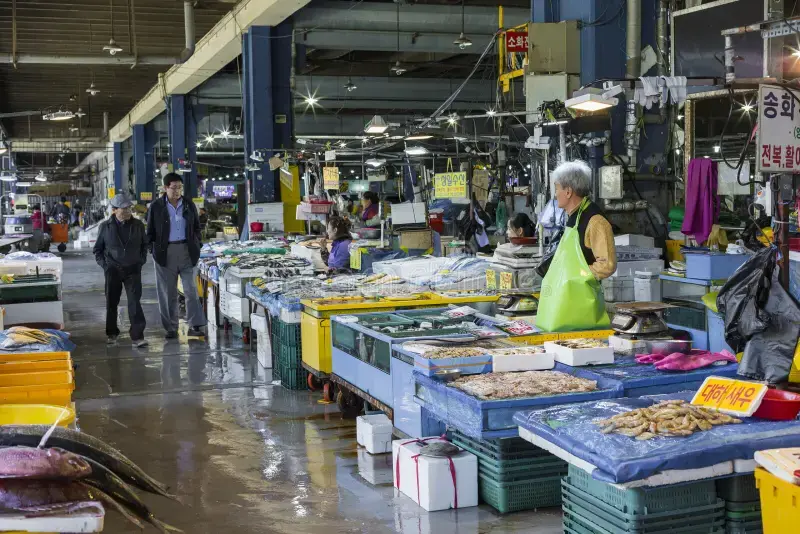FROM HANBOK TO HOTTEOK: EXPLORING SEOUL’S GWANGJANG MARKET
- Elena-Daniela Sandu

- Sep 15
- 3 min read

If you are a fan of K-dramas a lot, you’ve probably noticed that traditional markets play a central role in South Korea’s culture and daily life. Gwangjang Market (광장시장), a must-visit destination for food lovers and cultural explorers, is found right in the heart of Seoul, in the Jongno District. Gwangjang was first established in 1905 and is one of South Korea’s oldest markets. It blends tradition, vibrant aromas, and local craftsmanship into a unique and immersive experience.
1. A GLIMPSE INTO HISTORY

Founded by a group of Korean merchants during Japanese colonial rule (1905), Gwangjang Market was South Korea’s first-ever permanent daily market, which meant a bold act of economic independence at that time. It was originally called Dongdaemun Market, but it was renamed Gwangjang Market in 1960, a name inspired by two nearby bridges, Gwaggyo and Jangkyo.
2. THE FOOD PARADISE

Gwangjang is definitely one of Seoul’s top food destinations for locals and tourists alike, being known worldwide for its traditional street delicacies. Today, more than 60.000 visitors flood the market daily to enjoy iconic dishes such as Bindaetteok (mung bean pancakes), Mayak Kimbap, Tteokbokki, Sundae (blood sausages), Yukhoe (raw beef) and Kalguksu (knife-cut noodles).
3. WHAT ELSE TO EXPLORE

Surprisingly, Gwangjang’s earlier fame came as a textile and hanbok district, not as the food paradise that people love today. Although today’s main attraction is food, the market still houses shops that sell silk fabric, bedding, vintage clothing items, and traditional clothing accessories. In the alleys off the main food court, you can browse vibrant textiles, sewing materials, and antique goods at bargain prices.
4. THE MARKET EXPERIENCE
The market has a unique charm, and as soon as you step into the area, you feel enveloped by a magical atmosphere. As you weave through the narrow alleys, you can hear the sound of sizzling pans that mixes with lively chatter, while locals and tourists share small tables in a warm and bustling atmosphere. Just around the corner, the steady hum of sewing machines reveals vendors crafting hanbok and handmade goods, adding an authentic touch to the vibrant food-filled scene.
5. PRACTICAL INFORMATION
· ADDRESS: 88 Changgyeonggung-ro, Jongno-gu, Seoul 03195
· OPENING HOURS:
General market: 09:00–18:00 (Mon–Sat; closed Sunday)
Food alley (street food zone): 09:00–23:00 (open daily)
· TRANSPORT:
3-minute walk from Jongno 5-ga Station (Line 1, Exit 8)
5-minute walk from Euljiro 4-ga Station (Lines 2 & 5)
2-minute walk from the bus station: Bus numbers 101, 103, 143, 201, 260, 262, 271, 370, 720, and 721
BEST TIME TO VISIT:
Weekday mornings or early afternoons are ideal for enjoying popular stalls before the lunch rush, while weekend or evening visits are great for soaking up the street food festival vibe, but expect queues.
TIPS FOR FOREIGNERS:
- Bring cash, as some stalls prefer it.
- Bargaining is possible in textile shops.
- Pointing or menu photos work well if you don’t speak Korean.
- Sharing a table with locals is common and part of the authentic experience.
From its founding in 1905 to its modern-day fame on Netflix, Gwangjang Market is more than just a shopping arcade. Everyone agrees that Gwangjang is a sensory feast, a culinary paradise, and a living piece of Korean culture. Whether you're biting into a crispy bindaetteok or bargaining for hanbok fabric, every moment here feels authentically Korean.
Will Gwangjang Market be your first stop on your Seoul adventure? Let us know!



Comments